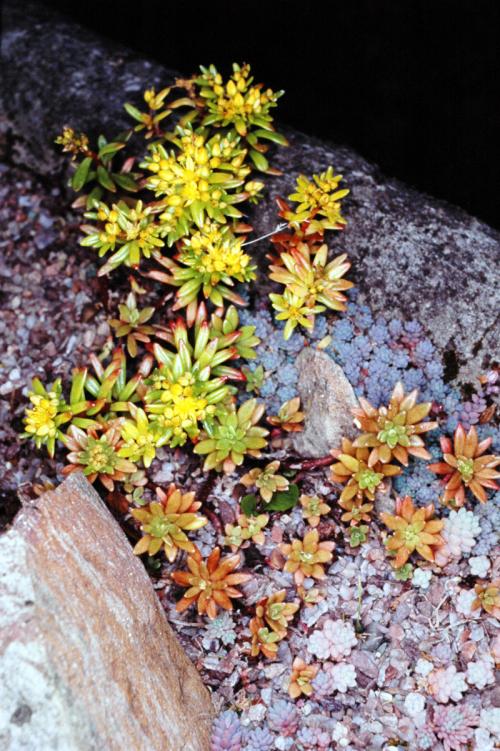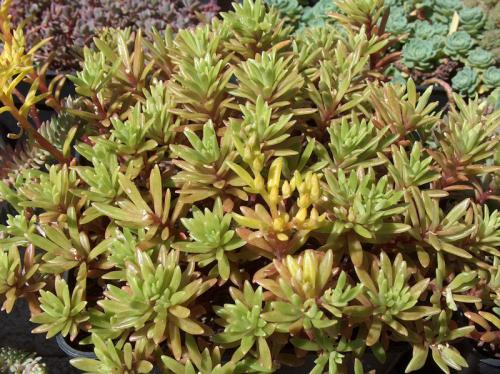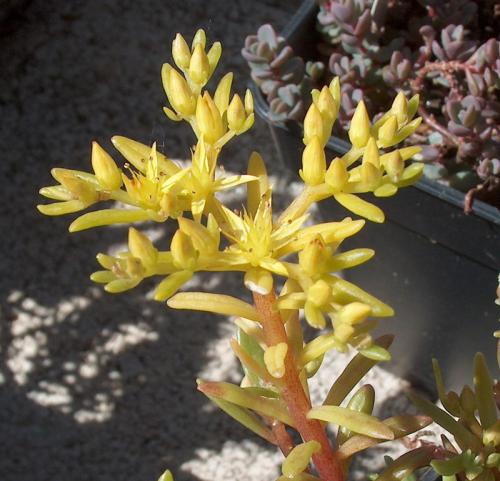HAKONENSE Makino, 1901
Synonyms :
Sedum habonense Makino (s.a.)
Sedum rupifragum Koidzumi (1938) / Sedum hakonense var. rupifragum (Koidzumi) Ohwi (1965)
Distribution : China (Northern Guangdong), Japan (Southern Hondo, Honshu), in cool-temperate mountain forests, on rocks or tree trunks, 1600 - 1700 m.
Description (according to IHSP, 2003) :
Perennial herbs with rather stout basally much branched suberect stems, 6 - 8 cm tall.
Leaves alternate, narrowly oblanceolate, somewhat rounded, fleshy, 5 - 25 mm.
Inflorescences : Flowering branches erect to ascending, loosely tufted, decumbent at the base, 6 - 10 cm tall, inflorescences rather lax many-flowered cymes with 3 sometimes forked cincinni, bracts leaf-like, 4 - 10 mm.
FIowers 4- (rarely 5-) merous, sessile, sepals broadly sessile, unequal, triangular, obtuse, nodulate near the tip, 1-veined, 0,5 - 1 mm, petals ovate-lanceolate to semi-oblong, acute, shortly mucronate, yellow, 4 – 4,5 mm.
Cytology : 2n = 136 (as S. rupifragum)
Sedum rupifragum has 4- or 5-merous flowers. Ohwi (1965: 35) included it in S. hakonense as variety, while Ohba (2001: 27-28) recognized it as a separate species.
Ray Stephenson (Sedum, Cultivated Stonecrops, 1994, p 159 & p 169) :
In 1994, R. Stephenson considered Sedum hakonense and S.rupifragum as distinct species. His comment Nov. 2012 : “At the time I wrote the book I had one of each and they looked different. I still have no field experience of either nor am I likely to gain any. If Henk came to the conclusion they were different forms of the same species then I cannot argue. S. rupifragum was much hardier for me but if it is a widespread species then this isn't surprising.”
Sedum hakonense (p 159) :
Common name : Matsu-no-ha-mannengusa
Sedum hakonense is a fairly typical Japanese sedum resembling S. rupifragum and others. It is a creeping, then ascending plant, much branched from the base, with linear, loosely tufted, scattered leaves that are more succulent than those of S. lineare. Plants are usually no more than 5 cm (2 in) tall, but stems are often twice this length. Many 4-partite, pale yellow, sessile flowers of late summer are carried on a 3-branched cyme. The species is exceptionally rare in cultivation, even in Japan.
Habitat : This stonecrop is indigenous to mountains of southern Honshu, Japan.
Main points of distinction : Leaves are not particularly distinct, but 4-partite flowers are rare in this group. Tiny sepals are unequal and fairly deltoid. Turgid fruit are pronounced kyphocarpic.
Variation : Unable to comment.
Horticulture : Sedum hakonense is almost hardy. If you manage to acquire a piece to pro-pogate, give plenty of cuttings away so you can beg one back if you lose your plant.
Sedum rupifragum (p 169)
Common name : Ō-me-no-mannegusa
Usually an erect, tufted stonecrop, Sedum rupifragum grows to about 8 cm (3 in) high. Stems, particularly in winter, are topped with loose rosettes of bright, flat, quite narrow, elliptic, patent leaves. Leaves have a median groove on upper surfaces and are deflexed towards their tips. In summer, rosettes are less well-defined as stems elongate, and leaves are present on the upper two-thirds. Flowers in early summer are on 3-branched inflorescences.
Habitat : This species is native to mountains of southern Honshu.
Main points of distinction : Three features are the best means of identification: rosettes in winter are very distinct, the neat upright nature of short stems, and the shape of leaves. Small, unequal, deltoid sepals are neither free nor spurred. n = 68.
Variation : Due to the limited range of this species in the wild, little variation is expected.
Horticulture : The species is a very neat, slow to propagate, and almost always hardy in Mid Northumberland. It makes an excellent alpine plant for a shallow pan, but is equally beautiful in a rock garden, a raised bed, or a stone trough. It is one of the most refined species in the Far East group, but its diminutive nature necessitates that it be grown on an elevated site.
________________________________________________________________________
The name ‘Chocolate Ball’ is often wrongly attributed to S. hakonense, however it is a nursery name of S. polytrichoides.


